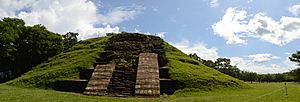Cihuatán facts for kids
Cihuatán was a very large ancient city in central El Salvador. It was built long ago, before Christopher Columbus arrived in the Americas. This city was a big center in the southern part of Mesoamerica, a region where many important ancient cultures lived. Experts believe Cihuatán existed between about 950 and 1200 AD.
Archaeologists, who are like history detectives, studied Cihuatán in the 1970s. They worked with El Salvador's Cultural Heritage Administration. By 1980, they had mapped out a huge area of the city, covering about 63 hectares (155 acres). This area included more than 900 buildings!
Contents
Where is Cihuatán Located?
Cihuatán is found in the town of Aguilares. This is in the San Salvador area, right in the middle of El Salvador.
The Story of Cihuatán
Cihuatán was likely built in the 8th or 9th century AD. Before that, no one lived there. The city did not last very long, maybe only about 100 to 150 years.
Cihuatán was founded around the same time that other big cities in the area were being left empty. These older cities had strong connections to the Maya people in Honduras. Cihuatán might have grown because of big changes happening after the Classic Maya collapse. This event caused old trade routes to shift.
Even though we don't know who the leaders of Cihuatán were, some of the buildings look like Maya architecture. About 100 to 150 years after it was built, Cihuatán was destroyed by a huge fire. This fire spread very quickly through the city.
Archaeologists found signs that people fled, leaving their things behind. They found many spear points in the burnt layers. There were also signs of people who couldn't escape, found in drains in the main temple area.
Cool Things Found at Cihuatán
Archaeologists found many interesting items at Cihuatán.
- Ceramics: They found large clay statues of gods from central Mexico, like Tlaloc (the rain god) and Xipe Totec (the god of spring and new growth). These statues look very similar to ones found in central Mexico. They also found everyday pots and bowls made locally. These were common in southern Mesoamerica during that time. Other ceramic items included incense burners with spikes, small human-like figures, wheeled toys, and clay boxes. Both local and imported ceramics show connections to styles from Veracruz, a region on the Gulf coast of Mexico.
- Obsidian Tools: A lot of obsidian was found. Obsidian is a sharp, glass-like volcanic rock. It was used to make tools. Archaeologists found obsidian cores (the raw material), sharp blades, and other tools. They also found some spear points made of stone, but these were not as common. These stone tools were typical for the time period.
Exploring the City of Cihuatán
Cihuatán was a very big ancient city. It had two main ceremonial centers. These are like the important public areas where religious ceremonies and big events happened. They are called the Eastern and Western Ceremonial Centres.
In 1978, the Western Ceremonial Centre was cleared of plants and mapped. Archaeologists also dug up some houses that had been quickly left because of the fire. This meant many household items were saved when the walls fell. The main buildings in the city center were built in a style common across Mesoamerica. However, outside these main areas, the buildings looked more like Maya architecture.
Western Ceremonial Centre
This center has a large pyramid. It also has several platforms that once held buildings. There are two I-shaped Mesoamerican ballcourts. These were places where ancient ball games were played. Experts think the style of buildings here shows influence from the Veracruz region of Mexico. Tests show this center was first built in the 8th or early 9th century AD.
Eastern Ceremonial Centre
This center was built at the same time as the Western Ceremonial Centre. But it looks different in its layout and style.
NW 1/NW 3 Residential Area
This was a group of homes on a terrace about 34 meters (112 feet) long. It had two houses and two smaller buildings, plus their courtyards. The smaller buildings might have been used to store maize (corn). This group of buildings was left quickly because of the fire. Many household items were found right where they were left. These included large jars for storing food, cooking pots, and decorated ceramics. Archaeologists also found evidence that people made obsidian tools here. They also found signs that people spun cotton into thread.
P16 Structure
This was a large building on the West Terrace. It was probably in the main marketplace of the city. It was built like a house, but it likely had a special purpose. It also burned down. Inside, archaeologists found everyday trash. The south end of the building was a very large workshop. Here, people made obsidian tools for working with wood.
P22 Platform
This was a small ceremonial platform. It was located to the northwest of the Western Ceremonial Centre. It is not well preserved, but it was rectangular. Its entrance stairway was on the west side.
See also
In Spanish: Cihuatán para niños



